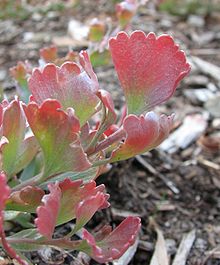| Adenanthos cuneatus | |
|---|---|

| |

| |
| Scientific classification | |
| Kingdom: | Plantae |
| Clade: | Tracheophytes |
| Clade: | Angiosperms |
| Clade: | Eudicots |
| Order: | Proteales |
| Family: | Proteaceae |
| Genus: | Adenanthos |
| Section: | Adenanthos sect. Adenanthos |
| Species: | A. cuneatus
|
| Binomial name | |
| Adenanthos cuneatus | |

| |
| Distribution of A. cuneatus, shown on a map of Western Australia's biogeographic regions.[1] | |
| Synonyms | |
| |
Adenanthos cuneatus, also known as coastal jugflower, flame bush, bridle bush and sweat bush, is a shrub of the family Proteaceae, native to the south coast of Western Australia. The French naturalist Jacques Labillardière originally described it in 1805. Within the genus Adenanthos, it lies in the section Adenanthos and is most closely related to A. stictus. A. cuneatus has hybridized with four other species of Adenanthos. Growing to 2 m (6 ft 7 in) high and wide, it is erect to prostrate in habit, with wedge-shaped lobed leaves covered in fine silvery hair. The single red flowers are insignificant, and appear all year, though especially in late spring. The reddish new growth occurs over the summer.
It is sensitive to Phytophthora cinnamomi dieback, hence requiring a sandy soil and good drainage to grow in cultivation, its natural habitat of sandy soils in heathland being an example. Its pollinators include bees, honey possum, silvereye and honeyeaters, particularly the western spinebill. A. cuneatus is grown in gardens in Australia and the western United States, and dwarf and prostrate forms are commercially available.
- ^ "Adenanthos cuneatus". FloraBase. Western Australian Government Department of Biodiversity, Conservation and Attractions.